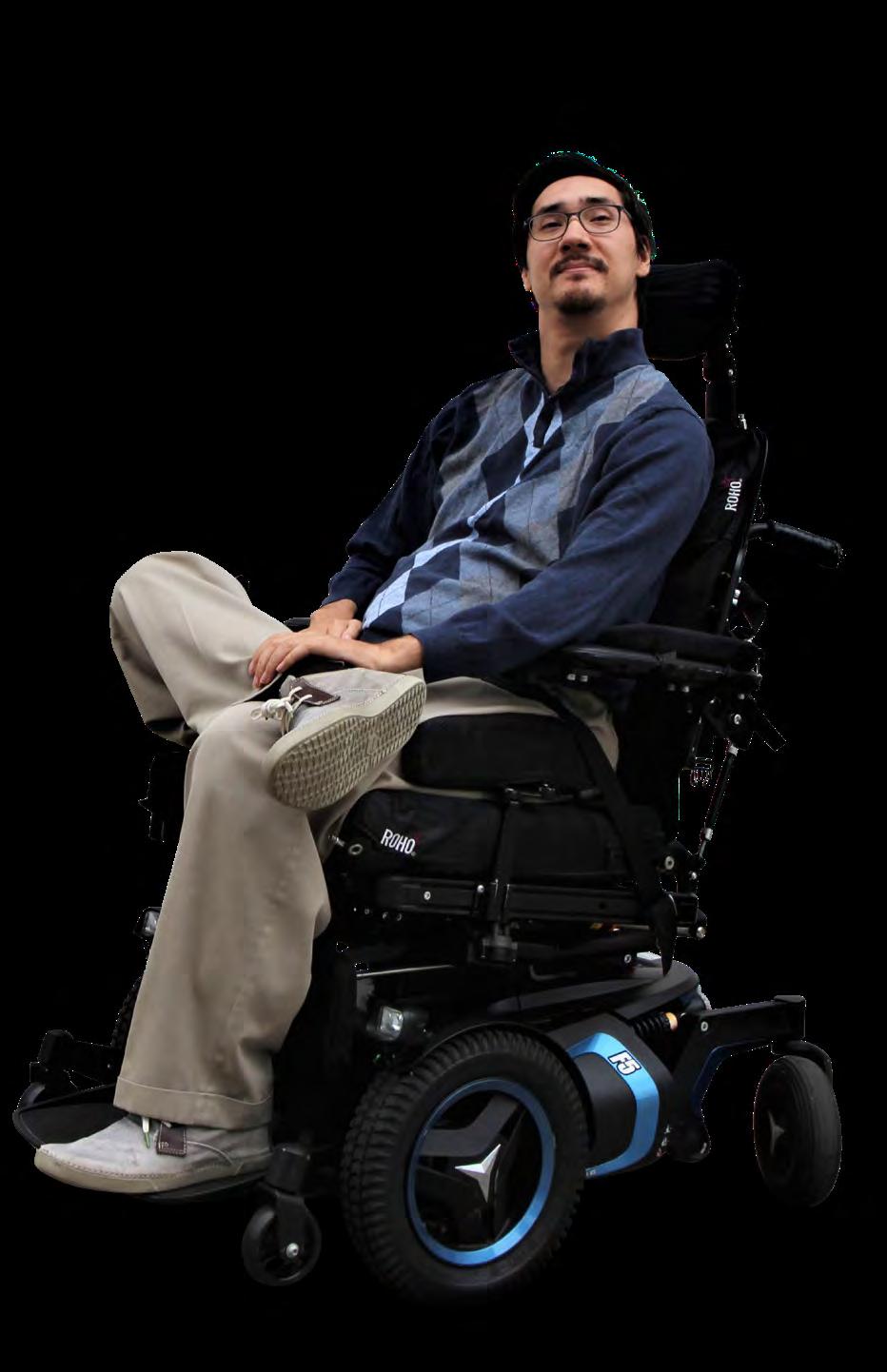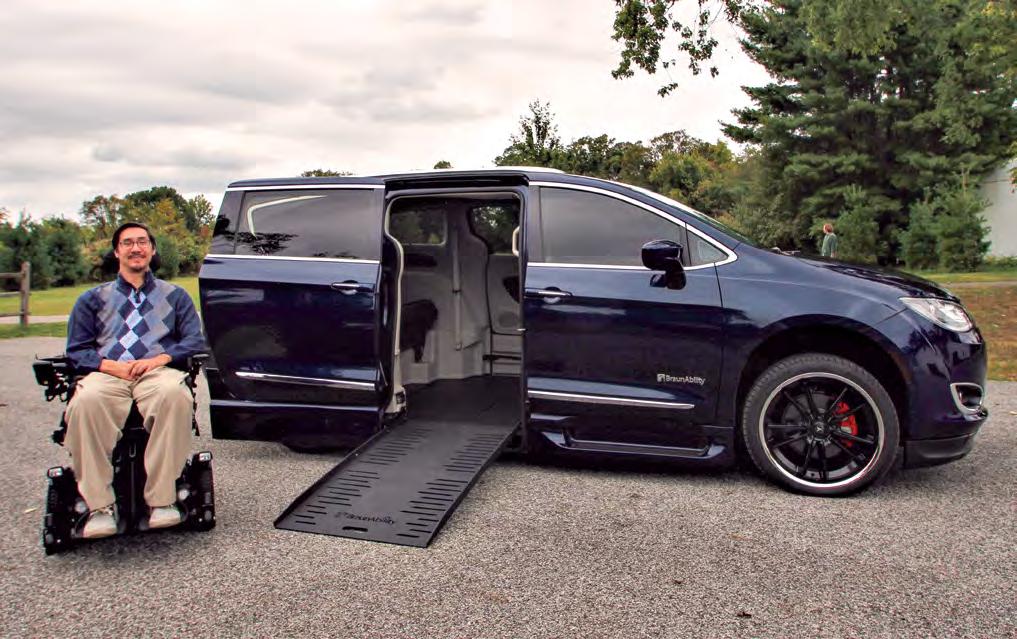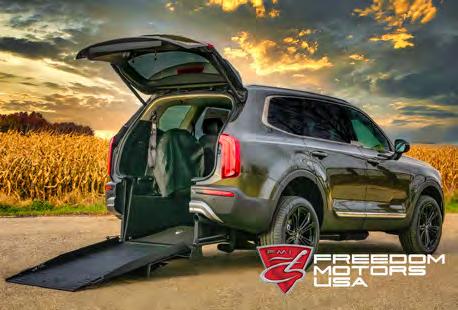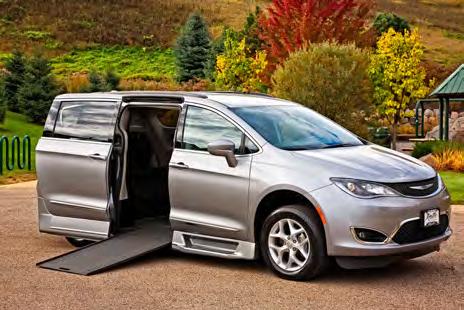
12 minute read
AUTOMOTIVE
Products and resources to keep — or get — you behind the wheel.
Advertisement
When he’s not drifting the streets of suburban Philadelphia, Randall Duchesneau is an accessibility specialist at the U.S. Access Board, where he provides training and assistance to the public on the ADA accessibility standards. A C5-6 quadriplegic, Duchesneau is an active SCI mentor and a founding member of the United Spinal Association Greater Philadelphia Chapter.
ROCKING My MINIVAN
BY RANDALL DUCHESNEAU
Randall Duchesneau and his customized Chrysler Pacifica

It may not be a Maserati, but my customized Chrysler Pacifica with BraunAbility conversion is something I can not only use, but enjoy. It expresses my personality, gives me the freedom and independence of being back behind the wheel, and brings a smile to my face every time I see it in the driveway.
It took me 10 years from the time of my injury to learn to drive, pick out my ride and make it my own. Here’s how I did it.
LEARNING TO DRIVE (AGAIN)
Learning to drive again can be a long road, and for me, a C5-6 quad who uses a power chair, it took several years. It can also be expensive depending on the level of adaptations you need. It’s worth inquiring with your state Voc Rehab to see if they will help pay for driver training and vehicle modification. Another option is to set up a fund through a site like Help Hope Live, where people can provide taxdeductible donations to your campaign. It’s kind of like GoFundMe, except it’s a reputable nonprofit for people with SCI and contributions are tax-deductible.
Once your funding is secure, finding the right driving instructor is essential. Talk with your peers, ask the staff at your local rehabilitation hospital or check the Association for Driver Rehabilitation Specialists member directory to find instructors in your area. Be sure they have worked with people at your level of injury and have the appropriate driving equipment available for you to use.
I signed up for driver training courses through Moss Rehab in the Philadelphia area as soon as I was out of inpatient rehabilitation. The first system I tried was the electronic gas and brake by Electronic Mobility Controls. It had a ministeering wheel that sat in front of my chest. Turns out this is a pretty common setup for high-level quads and requires very little strength and mobility to operate. It’s like using a joystick on a power wheelchair. This system works for many people, but it requires costly adaptations to the vehicle and I wanted to explore other options. I also was having a difficult time not being able to “feel the brake.” I’d try to slightly touch the brake but often came to a screeching halt.
The next system I tried was the Scott Driving System, which is a purely mechanical adaptation that would allow
Duchesneau’s van has a fold-out ramp to allow for more headspace.

me to still feel the vehicle and gauge how much pressure I was putting on the brake. This system was unlike anything I had seen or heard about before. It allowed me to drive using just my right arm by “airplane-ing” — making a similar motion to the one kids make when they turn their arms into airplanes and pretend to fly around the room. Due to my injury I could airplane right, but could not always airplane left (I can supinate, but can’t pronate my arms). The Scott Driving System is a really interesting and clean interface, but not the right one for me.
It’s important to make sure we have regained as much strength and functional independence as we can, because that dramatically influences the level of vehicle modifications we need. Trying the Scott Driving System helped me realize I needed to get a lot stronger before taking up driving again.
Ten years and several stints of outpatient physical therapy
Red calipers amplify the cool factor of the customized rims.

later, I tried again. This time I was able to use a regular-sized steering wheel with a tri-pin grip. They were able to put the steering wheel on “reduced effort,” which makes it easier to turn. So as long as I was able to make the motion of turning a full-sized steering wheel, I no longer needed the steering column modified for a mini-steering wheel. In addition to reducing my needed modifications and costs, this would make it much easier for nondisabled drivers to drive my van and help out on long trips.
While attending an Abilities Expo to do more research, I discovered Drive-Master. This system uses a mechanical pull/push gas/brake with a modified vacuum braking system that requires less effort to depress the brake pedal. Since I’d strengthened my left arm through physical therapy, I wanted to give it a shot. I visited Drive-Master’s headquarters in Fairfield, New Jersey, and they let me try their vehicle. I had not been able to find this specific braking system at any of the local adaptive driving schools, and I wanted to try it.
I’m so glad I did. The controls fit under the steering column and there was still plenty of clearance for my knees. I could depress the brake with my arm fully extended with movement from my shoulder, so I didn’t need the use of any
The Drive-Master system works well for Duchesneau.

triceps. The brake was easy to push and hold, I could feel the vehicle, and I no longer had any concerns about stopping short. I was finally comfortable behind the wheel.
FINDING MY RIDE
The first time I went to a mobility dealership, I was shocked at the cost of an accessible vehicle. I couldn’t help but think I could get a Maserati for the same price. With many different types of accessible vehicles, options, and features, what did I need to know before making such an important decision? I realized I needed to do my homework before deciding on such an expensive purchase.
There are more interesting choices today than there ever have been for people who want to roll into their vehicle. A great way to start is by attending an Abilities Expo where you can talk with vendors and check out an array of accessible minivans, SUVs, pickup trucks and more. The next in-person Expo is scheduled for Los Angeles in March.
into the Chrysler Pacifica with BraunAbility conversion, I instantly knew it was the one. The center console touch screen was easy to reach and could control both media and climate. The rotary gear shift dial was easy to manipulate and didn’t require hand function like grasping or pressing buttons. Plus, the blue lights of the display and the curved dash made it feel like I was sitting in a spaceship. On top of that, it was large and spacious, and I was able to pull up further under the steering wheel and with greater ease than in other conversions I tried. Having spent years getting in and out of a wheelchair van multiple times a day, I’ve learned that the convenience of This graphic shows all the features of Duchesneau’s dashboard and steering system. getting in and out quickly and without having to worry about hitting things and maneuvering in
As a power chair user, I narrowed my search to minivans, tight spaces is well worth it.which generally fall into two categories: rear- and side-entry. Rear- I chose the “foldout” version, where the ramp is inside the entry offers better ground clearance at the cost of fewer interior vehicle next to the passenger side sliding door. This makes it configurations and limited space. Most importantly, it’s not impossible to use that sliding door without deploying the ramp, possible to drive from your chair in a rear-entry vehicle. Side-entry but also gives you extra floor-to-ceiling height. I went with the is more common, thanks to the room and options for wheelchair foldout ramp because I sit very high in my wheelchair and need users who want to drive, either from their wheelchair (like me) or as much extra headroom as possible. The in-floor ramp model by transferring to the driver’s seat. is a great option for those who don’t need the extra 2 inches of
At the Abilities Expo I tried several vehicles, but when I rolled height and prefer the wider ramp it comes with.

WHEELCHAIR ACCESSIBLE SUVS Available from Freedom Motors USA 800/625-6335 or freedommotors.com

From the originator of the first-ever minivan conversion comes a full range of wheelchair accessible SUVs. Available only from Freedom Motors USA, our innovative lineup of accessible small, mid and full-size SUVs includes Buick Enclave, Chevy Traverse, Hyundai Palisade and the Kia Soul, Sorento and Telluride. Why settle for a minivan? DARIOS DIGITAL HAND CONTROLS Available from KEMPF, Inc. 888/453-6738 or kempf-usa.com

KEMPF adapts vehicles for paraplegic drivers. With DARIOS, the digital accelerator ring, the driver keeps both hands on the wheel. The system appears to be a part of the original equipment of the vehicle. KEMPF features nationwide free at-home pick-up and delivery and lifetime warranty. KEMPF products are VA accepted.



CUSTOMIZING MY RIDE
In July I bought my Chrysler Pacifica. After almost 14 years with a spinal cord injury, I finally had a vehicle I could drive independently. It felt like a fresh beginning, a new chapter in my life. I was excited!
When I was in high school, I was very in to aftermarket modifications for my Toyota Celica. I had customized my ride with a VeilSide body kit, carbon fiber hood, neon under glow, an Xbox, and a number of performance modifications. Owning an accessible vehicle I could drive reignited that passion inside me. I started exploring the Pacifica forums to get an idea of what aftermarket modifications were available for a minivan. Here’s what I learned. Hopefully it will give you some ideas if you’re interested in tricking out your ride.
Window tint: My spinal cord injury makes it difficult for me to regulate my body temperature, and my skin can quickly turn red in the sun. I was surprised to find that there is now a “ceramic tint” that has better heat rejection and UV blocking capabilities than traditional window tint. I decided this was worth paying more for. I tinted just the front windows to match the factory tinted side and rear windows, which ended up being about 20% visible light transmission. If you have concerns about the legality of tinting in your state, talk to your local tint shop to get a better idea of what’s technically legal and what might get you a ticket. Aesthetically it was a huge improvement, and a noticeable difference in the summer heat. I definitely recommend going with ceramic tint if you live in a sunny, hot-weather state.
Rims: Aftermarket rims are a subjective style choice, and normally putting rims on a minivan would be laughable, but I think I was able to do it in a very tasteful way that gives the vehicle a much more aggressive look without being tacky. Rims are generally the most expensive modification, but I had just gotten a bonus at work, and was able to justify the expense to myself. These days some online websites sell rim and tire packages with a fitment guarantee, which I highly suggest unless you really did your homework. The forums have lots of examples of people putting rims on their rides, so you can get a good idea of what size to go with and how it will look. The Pacifica comes stock with 17, 18, or 20-inch rims depending on which trim you got. People on the forums had no problem putting 22-inch ones on their Pacificas. I ended up going with 22-by-9-inch rims with 265/35R22 tires. And, of course, with bigger rims I had to at least get the brake calipers painted red.
To learn more about wheel sizing, check out wheel-size.com. The site even has a handy calculator to compare your original setup to your modified setup and give you a better idea of clearances, overall diameter, side wall thickness and so on. It’s an awesome tool if you want to geek out.
Lights: For a final touch, I got a Govee Dreamcolor interior LED light kit on Amazon ($34.99) that I can control with my phone. It lets me do all kinds of silly things, like change colors and bounce to the music, but they’re actually really helpful for seeing the floor of the van when it’s dark — especially if I drop something.
Car detailing and protection: As I went down this rabbit hole, I found videos on car detailing from YouTuber Pan TheOrganizer to be quite helpful. There are tons of car washing and paint protection products out there, promising everything from a couple of months to seven years of protection. I ended up getting Turtle Wax Ice Seal N Shine since it had amazing performance test results, is easy to apply, lasts over six months, and only costs a couple of bucks. I’ll consider putting on a longer-lasting ceramic coating someday. You can DIY a ceramic coating, but there’s lots of prep work involved and you need a garage to let it cure for at least 24 hours. Unfortunately, my garage is full of medical equipment.
Insurance and Amazon Echo Auto: I signed up with Nationwide, which has a pay-per-mile program and an option to add extra coverage for vehicle modifications. Insurance ended up being a lot cheaper since I’m not driving that many miles yet. It also came with a free Amazon Echo Auto — think Alexa for your car. Amazon Echo Auto connects simultaneously to my vehicle’s speakers and uses the data from my phone. Unlike other options that might require me to press a button on the steering wheel, or unlock my phone screen, Amazon Echo Auto lets me make calls, play music, and so on completely hands-free. This is great because I currently do not take my hands off the steering wheel or gas/brake lever even for a second. Amazon Echo Auto has made the entertainment part of driving much more independent and enjoyable for me.
WHEELCHAIR ACCESSIBLE VANS Available from Rollx Vans 800/956-6668 or RollxVans.com


For over four decades, Rollx has been the nation’s premier manufacturer of accessible mini, full-size, and previously-owned vans. Rollx is a direct manufacturer with an inventory of over 200 vans in stock. Check out www.RollxVans.com to find out the latest inventory, pricing and rebates, or call 800/956-6668.







